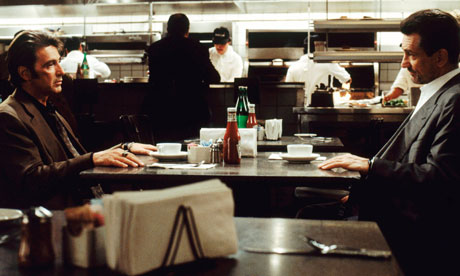Synopsis:
A six year old child is institutionalized after murdering his sister but escapes fifteen years later. He returns to the scene of the crime where he systematically sets his sights on murdering a group of teenagers who happen to live in the area.
Review:
‘Halloween’ does not intend to disgust, nor does it aim to sicken. What it does instead is to truly frighten the audience like a good old fashioned horror film should. The film is ingenious in its attempt to create a mood through its impeccable restraint in pacing. The film does not rush into violence. It merely waits and waits, causing an unheard of apprehension within the audience, until it finds the right note and then strikes with a vengeance.
‘Halloween’ has been credited by many critics as a film that influenced the slasher film craze that bombarded theatres in the 1980s and 1990s. Though not the first of its kind, this film did help to usher in an era of cinema that soon became monotonous and obvious. Films such as ‘Friday the 13th’ (1980), ‘Terror Train’ (1980), ‘Prom Night’ (1980), and ‘A Nightmare on Elm Street’ (1984) (as well as many others) all owe a tremendous amount of credit to ‘Halloween’. These films are mere exploitations of the success garnered by this film.
Some would say that there would never have been a ‘Halloween’ if it were not for ‘Psycho’ (1960). This is very true. ‘Psycho’ did set the standard of the modern day slasher film, but what ‘Halloween’ was able to do eighteen years later was to reshape and remold the genre into a viable, economically safe entity (‘Halloween’ was made for $325,000, and went on to make $47 million at the box office). The film arrived at a time when the film industry was looking for an easy and cheap way to make a profit. The slasher film provided this opportunity through its relatively unknown casts, cheap generic sets, and low production values. Nobody cared about the acting because it was all about a young beautiful cast being systematically eliminated/slaughtered by a ferocious beast.
As was noted earlier, ‘Halloween’ does not intend to disgust. The film is very deliberate in its pacing, which creates an aura of suspense and dread. Through every death scene we encounter, there is no rush to the finish line. From the first sequence of the film where we move around and about the house, our eyes being the lens of the camera dictated through a P.O.V. shot, we come to understand that this film is in no hurry to achieve an answer to the problems it is creating. During the first scene, the camera (situated outside) focuses on a young woman and a young man becoming intimate on the couch. They soon head upstairs to the bedroom. The camera turns and heads to the backdoor. The camera/character walks into the house and into the kitchen. The camera then pauses and looks at a drawer. A small, child like hand reaches down and pulls out a knife. As the camera/character makes its way to the stairs, it pauses and hides in the living room as the young male exits the house after his illicit affair. The camera then slowly makes its way upstairs and pauses, as we once again see a small hand reach out and pick up a small clown mask. The clown mask is then placed upon the camera and we enter a bedroom where the young, naked girl is combing her hair. As the camera moves closer, the girl becomes aware of the presence and turns. But it is too late. The character pulls out the knife and begins to assault her with it. This is a truly terrifying and unnerving beginning to a film. It is only when the character has exited the house and his mask is removed (this is where the P.O.V. perspective ends) that the audience discovers that it is a young boy in a clown costume. The use of music, lighting, and camera shots all add tension to an already disturbing sequence.
The film is very simple in its structure. A killer is sent away only to escape and return home to continue his onslaught. The theme has become a staple of the horror genre because of its relatively simple explanation as to why there is a killer on the loose. If the technique worked once and made the film a tremendous amount of money, then why not exploit it for future use.
John Carpenter directed this film, and though I do not care for many of his movies (‘Ghosts of Mars’ (2001) anyone?), Carpenter perfectly balances suspense with the mundane. As characters speak, they do so in relatively normal, boring teenage banter. However, Carpenter never allows the audience to forget about this unknown presence that has infiltrated the normality of this city. Carpenter’s framing and camera angles (his use of the foreground and background in many scenes are amazing in their structure, and have been clearly lifted by countless others intending to recreate the same effect for their horror films), are wonderfully exploited, and he achieves a tremendous amount of detail from them. For instance, in one scene where Laurie (Jamie Lee Curtis) is walking away from the camera down the street, Carpenter positions the camera perfectly to capture the shoulder of the killer (Michael Myers) enter the foreground of the frame and watch her as she walks away. Laurie is unaware of her dangerous predicament, but the audience is now fully alerted to this unknown, unseen presence. We pray that she will just turn around.
John Carpenter also composed the music to this influential horror film, and no review would be complete without mentioning it. To say the least, the music is eerie and terrifying. The amount of emotional attachment the music connotes is remarkable in that it sets the mood of the film from the very beginning. The audience is fully aware that this is not going to be a happy story. It is going to strive to unnerve, disturb, and frighten. The music is highly representative of the power of this picture. Even today, the piece is still one of the most recognizable themes in film history.
For those who have not seen this film, do it. Certain scenes from the film were not discussed for the simple reason that it would alter the experience of witnessing them for the first time. This film has become highly influential, and the character of Michael Myers is now viewed as a truly iconic figure within the horror genre.
See it for many reasons but definitely see it for the pacing of the story and the construction of a truly frightening atmosphere. The use of lighting adds a sense of dreariness and bleakness to the overall understanding and reading of the film. However, the greatest achievement of this film is in it’s refusal to become a blood and gore fest. The film relishes in its role as a suspense picture. In many ways, the film is more of a thriller/suspense then an outright horror flick. It is one of the greatest suspense films ever created, and most likely one of the more important one’s of the past thirty-five years.



